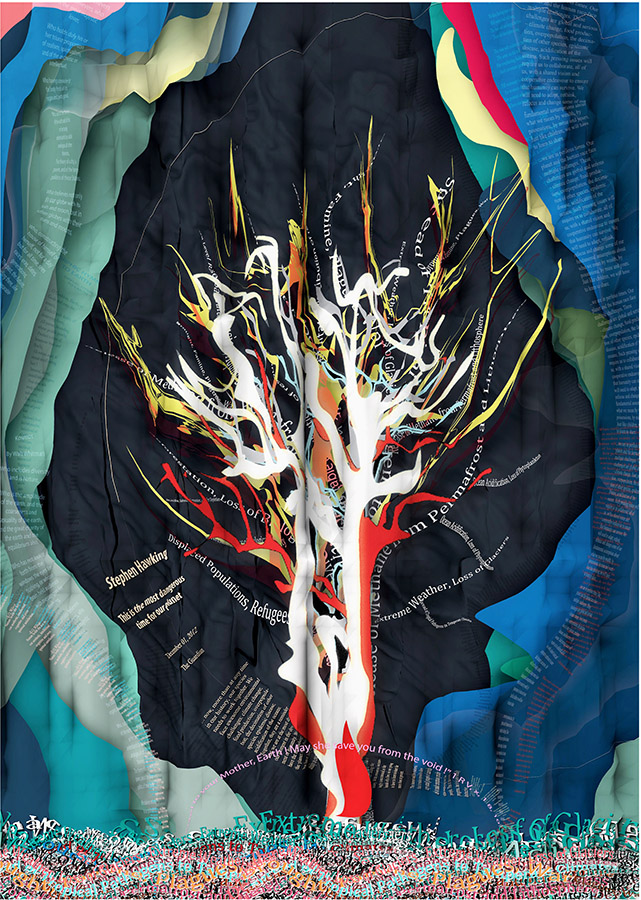
The Bonfire of the Anthropocene
admin11 June 26, 2018 No Comments
“Crawl to you mother Earth! May she save you from the Void!”
Rig-Veda X 18.13
A multitude of human and ecological crises have become increasingly hard to ignore over the past decades: the atmospheric accumulation of greenhouse gasses; the depletion and destruction of aquifers; drought; deforestation; desertification; the loss of glaciers and polar ice; the loss of biodiversity; sea level rise; ocean acidification; threats to our planet’s free oxygen posed by the decline both of the rainforests and the microscopic phytoplankton on the surfaces of the oceans; the corruption of the biosphere by plastics and other pollutants; the spread of waterborne diseases and other public health threats; and the advent of population displacements, climate refugees, hunger, and homelessness.
The list goes on. In all of their multiplicity, these particular crises compound themselves in vicious cycles that threaten the ecological possibilities of human life and, perhaps, most of the other life on the on the planet. The term “climate change” includes many of these phenomena as special cases; but another, more inclusive description of such problems is provided by the term, “Anthropocene epoch,” a concept that ties all these phenomena back to a single cause. Human beings. The designation was coined to define the period of recent geological history that begins when human impact on the Earth’s geology and climate became significant. Debate exists on when the Antropocene began, with proposed dates running from the agricultural revolution down to the detonation of the first nuclear weapon in 1945. But there is little doubt that we are currently experiencing its effects.
More to the point, as we enter the third millennium we are increasingly aware that human activities have begun to endanger the ecosystems that have evolved and maintained the habitability of the planet over the last two billion years. Obvious points to begin a discussion of this epoch include the increasing frequency of unprecedented high temperatures and the extreme weather events of past decades. But it has been hot before—too hot for most of what could survive today. It is worth noting that, on Earth, life began in conditions rather like those now found on Venus: in a much hotter, largely CO2 atmosphere with pressures perhaps 90 times the current value. Life itself tempered these conditions with the evolution of photosynthesis in oceanic phytoplankton. During the hundreds of millions of years following their emergence, these organisms populated the surfaces of the oceans reducing most of the original atmospheric carbon to free oxygen, and during the 2 billion following that oxygenation of the atmosphere, increasingly diversified, complex, life has developed. Thus life on our planet began in a world that remained alien until it was “terraformed,” or made earthlike, by the new forms of life.
Today, the temperate conditions that support advanced life exist only through the management of atmospheric carbon levels by oceanic plant life, terrestrial forests, and other green and growing things. Oxygen producing organisms consume and fix atmospheric carbon which is sequestered through biological and, over the ages, geological processes. This counterbalance between oxygen production and carbon cleansing is known as the “carbon cycle.” Just as importantly, the oxygen extracted from atmospheric carbon maintains the planet’s temperatures within the range of human habitability. Free oxygen does not absorb infrared energy as well as greenhouse gasses, so solar energy can radiate back into space as heat much more readily than would be possible for atmospheres with greater carbon content.
However, our evolution as a species is now at cross purposes with the evolution of something else that enabled us to become human: our technology. If the evolution of the ecosystems that gave rise to human beings could be said to operate on principles, these would likely include synergy, mutuality, holism, balance, recyclability, regeneration, sustainability over very long terms, and the degradability or impermanence of life’s large organic molecules, etc. Traditional technologies and crafts operated largely within these constraints and within the constraints of the carbon cycle. Yet contemporary technology operates increasingly by other principles. Over the past several centuries, technology has made remarkable advancements, but so have short-termism, overconsumption, waste, the equation of desire with need, the generation of boundless externalities, and the creation of ever more problems without good solutions. These choices are most succinctly noted in our twenty-first century carbon cycle, which runs from petroleum to plastics and the atmospheric CO2 overburden. Diamonds are not the only forms of carbon that are forever.
The air we breathe has been the path of our evolutionary journey over the past two billion years. Yet, very few of us will last more than three minutes without oxygen. Is asphyxiation a natural death? Considered from an evolutionary point of view, it is the most natural death possible. We cannot separate climate chemistry from the history of the human metabolism. We would do well to consider who we are, where we came from, what we really need, and what we will be able to leave for posterity. We must reevaluate our principles.
Category : Uncategorized